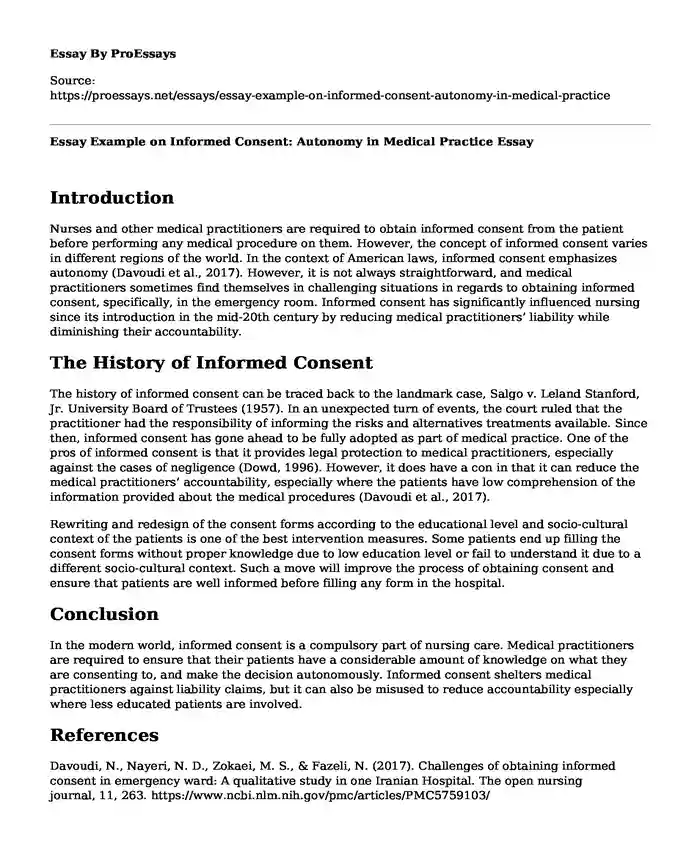Introduction
Nurses and other medical practitioners are required to obtain informed consent from the patient before performing any medical procedure on them. However, the concept of informed consent varies in different regions of the world. In the context of American laws, informed consent emphasizes autonomy (Davoudi et al., 2017). However, it is not always straightforward, and medical practitioners sometimes find themselves in challenging situations in regards to obtaining informed consent, specifically, in the emergency room. Informed consent has significantly influenced nursing since its introduction in the mid-20th century by reducing medical practitioners’ liability while diminishing their accountability.
The History of Informed Consent
The history of informed consent can be traced back to the landmark case, Salgo v. Leland Stanford, Jr. University Board of Trustees (1957). In an unexpected turn of events, the court ruled that the practitioner had the responsibility of informing the risks and alternatives treatments available. Since then, informed consent has gone ahead to be fully adopted as part of medical practice. One of the pros of informed consent is that it provides legal protection to medical practitioners, especially against the cases of negligence (Dowd, 1996). However, it does have a con in that it can reduce the medical practitioners’ accountability, especially where the patients have low comprehension of the information provided about the medical procedures (Davoudi et al., 2017).
Rewriting and redesign of the consent forms according to the educational level and socio-cultural context of the patients is one of the best intervention measures. Some patients end up filling the consent forms without proper knowledge due to low education level or fail to understand it due to a different socio-cultural context. Such a move will improve the process of obtaining consent and ensure that patients are well informed before filling any form in the hospital.
Conclusion
In the modern world, informed consent is a compulsory part of nursing care. Medical practitioners are required to ensure that their patients have a considerable amount of knowledge on what they are consenting to, and make the decision autonomously. Informed consent shelters medical practitioners against liability claims, but it can also be misused to reduce accountability especially where less educated patients are involved.
References
Davoudi, N., Nayeri, N. D., Zokaei, M. S., & Fazeli, N. (2017). Challenges of obtaining informed consent in emergency ward: A qualitative study in one Iranian Hospital. The open nursing journal, 11, 263. https://www.ncbi.nlm.nih.gov/pmc/articles/PMC5759103/
Dowd, S. B. (1996). The Legal, Ethical, and Therapeutic Advantages of Informed Consent. Journal of Nuclear Medicine Technology, 24(2), 129-131.
http://tech.snmjournals.org/content/24/2/129.full.pdf.
Salgo v. Leland Stanford Jr. University Board of Trustees. (1957). 154 Cal. App. 2d 560, 317 P. 2d 170.
Cite this page
Essay Example on Informed Consent: Autonomy in Medical Practice. (2023, Nov 01). Retrieved from https://proessays.net/essays/essay-example-on-informed-consent-autonomy-in-medical-practice
If you are the original author of this essay and no longer wish to have it published on the ProEssays website, please click below to request its removal:
- Providing High-Quality Food Services for Inmates in Detention or Correctional Facilities Proposal
- Dementia With Lewy Bodies (DLB) Paper Example
- Applying Ethical Principles in the Field of Health Care Case Study
- Nursing and Surgery - Questions and Answers Essay
- Essay on Syncretism in Chinese Thought: Unifying Daoism, Buddhism and Confucianism
- Hypothyroidism: A Disease Triggered by Low Iodine Levels - Essay Sample
- Essay Example on End-of-Life Care: Relief for Suffering and Grief







